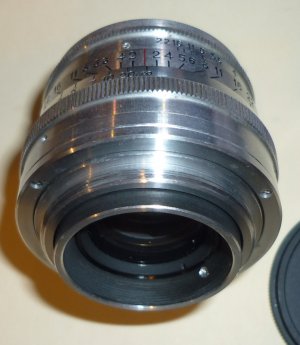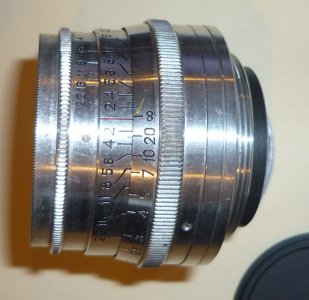titrisol
Bottom Feeder
This has probably been asked before, but for LTM is there a table of the distance flange to rear of lens for calibrating RF?
I'm a latecomer to the LTM game, and I calibrated a Leica IIF for Elmar 5cm/3.5
When I got another lens, infinity was not calibrated in the RF, and since the rear of the lens pushes the little wheel to move the RF it just seemed logical that the distance between the flange and the rear of the lens must be calibrated as well.
I measured this distances and there are 0.1-0.2mm differences between lenses which should be enough to have poor focus at close distance (<2ft)
Thus I was wondering if there is a table somewhere?
I'm a latecomer to the LTM game, and I calibrated a Leica IIF for Elmar 5cm/3.5
When I got another lens, infinity was not calibrated in the RF, and since the rear of the lens pushes the little wheel to move the RF it just seemed logical that the distance between the flange and the rear of the lens must be calibrated as well.
I measured this distances and there are 0.1-0.2mm differences between lenses which should be enough to have poor focus at close distance (<2ft)
Thus I was wondering if there is a table somewhere?
TenEleven
Well-known
First of all, most LTM/M39/L39 lenses can not have their rangefinder cam calibrated.
For example in the aforementioned 50mm Elmar the helical that moves the lens is the same that moves the optical unit. Some others like Russian and some Japanese lenses use multiple interlocked helices to drive the lens and the RF cam. These also can not be calibrated, they can however be assembled wrong by mis-threading the helical into the wrong start, not threading the mechanism deeply enough into its mount or other similar mistakes.
Lastly from the above (I would need to know the type and make of the lens) it does not follow that if the RF cam is in misalignment that the optics, which are often set to the proper distance by metal spacers/shims completely independent of the RF are also misaligned. The flange distance for LTM is 28.8mm. However you might not find this helpful as you would need to know the back-focal distance for the lens, which varies unit by unit - thus shim washers are used at the factory to make each individual lens "sit correct".
I would guess that the lens in question has suffered previous inexpert "repair".
As a general piece of advice I must strongly suggest that whatever you do, DO NOT GRIND DOWN THE RF CAM.
As someone who has repaired close to a hundred LTM lenses I can tell you that all this does is makes it appear as if the lens works on that particular (most likely miscalibrated) body and renders it completely worthless to be only used for parts. I have had such lenses on my bench. This is not salvageable. This can not be undone. Please do not do this.
For example in the aforementioned 50mm Elmar the helical that moves the lens is the same that moves the optical unit. Some others like Russian and some Japanese lenses use multiple interlocked helices to drive the lens and the RF cam. These also can not be calibrated, they can however be assembled wrong by mis-threading the helical into the wrong start, not threading the mechanism deeply enough into its mount or other similar mistakes.
Lastly from the above (I would need to know the type and make of the lens) it does not follow that if the RF cam is in misalignment that the optics, which are often set to the proper distance by metal spacers/shims completely independent of the RF are also misaligned. The flange distance for LTM is 28.8mm. However you might not find this helpful as you would need to know the back-focal distance for the lens, which varies unit by unit - thus shim washers are used at the factory to make each individual lens "sit correct".
I would guess that the lens in question has suffered previous inexpert "repair".
As a general piece of advice I must strongly suggest that whatever you do, DO NOT GRIND DOWN THE RF CAM.
As someone who has repaired close to a hundred LTM lenses I can tell you that all this does is makes it appear as if the lens works on that particular (most likely miscalibrated) body and renders it completely worthless to be only used for parts. I have had such lenses on my bench. This is not salvageable. This can not be undone. Please do not do this.
titrisol
Bottom Feeder
That is exactly my fear, that the cam was wither worn out or has been grinded.
I have no doubts about the Elmar, as it was one with the camera (bought together in Germany in the 50s) but the other lens came out of used camera store and might have been worked on.
I have no doubts about the Elmar, as it was one with the camera (bought together in Germany in the 50s) but the other lens came out of used camera store and might have been worked on.
Which lens is this, and would be helpful to post some pictures. In the case of some lenses- they can be re-assembled incorrectly and this problem will result. With a Jupiter-3: I have ground down the mount and screwed the helical in deeper to align the RF cam. In the case of one post-war Zeiss "transition lens"- the only option was to grind down the RF cam. There are exceptions- when everything else fails.
If the RF cam is not driving the RF to infinity- it is possible to build up the RF cam. I use copper or mylar tape.
If the RF cam is not driving the RF to infinity- it is possible to build up the RF cam. I use copper or mylar tape.
titrisol
Bottom Feeder
It is a Jupiter 8 that was on a Zorki4.Which lens is this, and would be helpful to post some pictures. In the case of some lenses- they can be re-assembled incorrectly and this problem will result.
If the RF cam is not driving the RF to infinity- it is possible to build up the RF cam. I use copper or mylar tape.
I ran a test roll last night and havent yet developed it to see if the distances or RF are right
At infinity I have 7.83mm in the Elmar but only 7.76mm on the J8.
Elmar (10ft) 3.05m 6.68mm J8 3m 6.60
Attachments
titrisol
Bottom Feeder
PS Found SonnarBrian's comments on this thread, I guess this is a waste.
 rangefinderforum.com
rangefinderforum.com
Soviet lenses, leica cameras and vice versa
Hi! I've been wondering about this issue for quite some time, as I use both Leica cameras and FSU-cameras. I know the theory of difference in focal length, but I wanted to test what effect this had in practice, and if it is relevant at all. The findings were quite interesting to me, and as this...
 rangefinderforum.com
rangefinderforum.com
TenEleven
Well-known
Most Russian lenses can be adjusted to work decently well on a Leica, especially for Film where the tolerances have a bit more leeway.
However I do not find the strange half drilled hole in the bottom of that Jupiter-8 to be confidence inspiring. This lens most likely has some inexpert repair behind it.
Now I sadly forgot how exactly the Jupiter-8 of this generation goes together as I previously mainly repaired the ones which still had a focus nub. But if the RF cam was just misthread (the bottom does not look ground off luckily) it should be fixable. Once repaired, even without adjusting the lens in the way that Brian details it should be fine in daylight for further away subjects, but closer-in will get dicey.
However since the Russians played it quite loose with the tolerances to their (non Leica standard) you might get lucky and have a lens that focuses very close to Leica already.
Edit: The aperture index also looks off. It should use the distance focus mark as aperture index IIRC. So it seems very likely that this lens has a bad repair behind it.
However I do not find the strange half drilled hole in the bottom of that Jupiter-8 to be confidence inspiring. This lens most likely has some inexpert repair behind it.
Now I sadly forgot how exactly the Jupiter-8 of this generation goes together as I previously mainly repaired the ones which still had a focus nub. But if the RF cam was just misthread (the bottom does not look ground off luckily) it should be fixable. Once repaired, even without adjusting the lens in the way that Brian details it should be fine in daylight for further away subjects, but closer-in will get dicey.
However since the Russians played it quite loose with the tolerances to their (non Leica standard) you might get lucky and have a lens that focuses very close to Leica already.
Edit: The aperture index also looks off. It should use the distance focus mark as aperture index IIRC. So it seems very likely that this lens has a bad repair behind it.
Aperture is way off- so someone tried to shim it. I've seen worse work on drilling holes for screws. The RF cam does not rotate when focusing. That means you can add a layer of tape to build it up. I've done that on this version of the J-8. The next step is to properly shim the lens, and re-index the aperture.
That version of J-8: from the 1960s, and the quality was all over the place compared with the earlier Tabbed J-8.
That version of J-8: from the 1960s, and the quality was all over the place compared with the earlier Tabbed J-8.
titrisol
Bottom Feeder
Oh well, I got it in a Zorki4 camera I found at GoodWilll some years ago. Camera never worked so I had it in the "paperweight" box and only remembered when I got the Leica IIIf.Most Russian lenses can be adjusted to work decently well on a Leica, especially for Film where the tolerances have a bit more leeway.
However I do not find the strange half drilled hole in the bottom of that Jupiter-8 to be confidence inspiring. This lens most likely has some inexpert repair behind it.
Now I sadly forgot how exactly the Jupiter-8 of this generation goes together as I previously mainly repaired the ones which still had a focus nub. But if the RF cam was just misthread (the bottom does not look ground off luckily) it should be fixable. Once repaired, even without adjusting the lens in the way that Brian details it should be fine in daylight for further away subjects, but closer-in will get dicey.
However since the Russians played it quite loose with the tolerances to their (non Leica standard) you might get lucky and have a lens that focuses very close to Leica already.
Edit: The aperture index also looks off. It should use the distance focus mark as aperture index IIRC. So it seems very likely that this lens has a bad repair behind it.
It's unfortunate, the J8 and J3 are very good in Contax mount.
Glass is clean, focusing ring was stiff, but has become looser with exercise, and you;re right the aperture index is off.
That hole was a screw on the other side that "guides the lens" and I assume it also serves as a physical stop.
I will try Brian's solution with some mylar tape (0.08mm difference) after I develop the test roll.
Attachments
titrisol
Bottom Feeder
Update: I got the Zorki4 to fire in B at least. Placed frosted glass on it and tested the Jupiter and Elmar on it.Aperture is way off- so someone tried to shim it. I've seen worse work on drilling holes for screws. The RF cam does not rotate when focusing. That means you can add a layer of tape to build it up. I've done that on this version of the J-8. The next step is to properly shim the lens, and re-index the aperture.
That version of J-8: from the 1960s, and the quality was all over the place compared with the earlier Tabbed J-8.
While both were focusing correctly in the ground glass at 1, 2, 5m and infinity based on the lens markings, the Elmar was pushing the RF plow too much, at infinity I could see the treeline moved way past the setting. At my 2m test the RF read between 4ft and 5ft
Thus, after the Leica comes back form MrYe, I'll add some tape to the back of the Jupiter to match the RF.
Thanks guys
Share:
-
This site uses cookies to help personalise content, tailor your experience and to keep you logged in if you register.
By continuing to use this site, you are consenting to our use of cookies.



